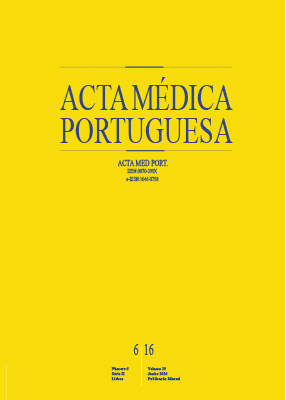Percutaneous Endovascular Aortic Repair with Local Anesthesia – One Day Surgery
DOI:
https://doi.org/10.20344/amp.7715Keywords:
Ambulatory Surgical Procedures, Aortic Aneurysm, Abdominal, Blood Vessel Prosthesis Implantation, Endovascular Procedures.Abstract
Introduction: To evaluate the results of the abdominal aortic aneurism endovascular treatment (EVAR), percutaneously and with local anesthesia, according to the concept of one day surgery.
Material and Methods: Unicentric, retrospective analysis of patients with aorto-iliac aneurysmal disease, consecutively treated by EVAR with percutaneous access trough the Preclose technique (pEVAR), according to the outpatient criteria, with one overnight stay in the hospital. The technical success, exclusion of the aneurysmal sac, endoleak, re-intervention and mortality were evaluated.
Results: Twenty consecutive patients (all male; mean age 74.65 years) were treated by EVAR with percutaneous access and local anesthesia, from which 95% (19) presented with abdominal aortic aneurysm and 5% (1) common iliac aneurysm. All implants were sucessfully performed, with an initial endoleak rate of 10% (2), determined by one type 1a endoleak successfully corrected intra-operatively and one type 2a endoleak diagnosed in the first imaging control, which sealed spontaneously on the second control. Initial technical success for percutaneous closure was 97.5%, with one case reported of femoral pseudo-aneurism, posteriorly treated by percutaneous thrombin injection. Median length of stay was one day [1-10], with a mean follow-up of 11.4 months [1-36]. Both the re-intervention and mortality rate are 0% for the selected period.
Conclusion: Our one day surgery model for the outpatient treatment of abdominal aortic aneurysm by the pEVAR technique is innovative, safe and effective, as long as the selection criteria are respected.
Downloads
Downloads
Published
How to Cite
Issue
Section
License
All the articles published in the AMP are open access and comply with the requirements of funding agencies or academic institutions. The AMP is governed by the terms of the Creative Commons ‘Attribution – Non-Commercial Use - (CC-BY-NC)’ license, regarding the use by third parties.
It is the author’s responsibility to obtain approval for the reproduction of figures, tables, etc. from other publications.
Upon acceptance of an article for publication, the authors will be asked to complete the ICMJE “Copyright Liability and Copyright Sharing Statement “(http://www.actamedicaportuguesa.com/info/AMP-NormasPublicacao.pdf) and the “Declaration of Potential Conflicts of Interest” (http:// www.icmje.org/conflicts-of-interest). An e-mail will be sent to the corresponding author to acknowledge receipt of the manuscript.
After publication, the authors are authorised to make their articles available in repositories of their institutions of origin, as long as they always mention where they were published and according to the Creative Commons license.









